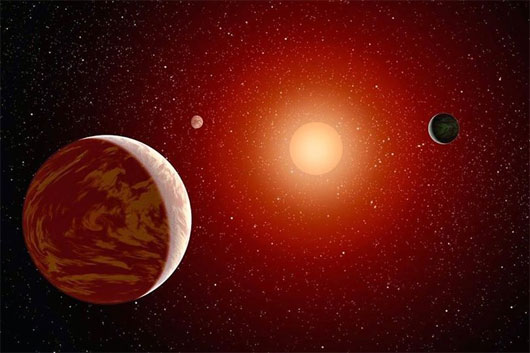Your planet is closest to Earth
Just 13 light-years from the solar system, a red dwarf is accelerating away from Earth, taking a planet that could be a giant version of the planet.
According to Space.com, one of the two planets orbiting a red dwarf Kapteyn is about five times the size of the globe and twice as old, within an area that can support life.

Simulation of 2 star Kapteyn rock planets - (Photo: NASA)
This is the closest planet to enter the gap that allows water to exist in liquid form, the premise for life to flourish.
Red dwarfs, named after a Dutch astronomer who discovered it in the 19th century, are the most common type of star in our galaxy.
While the solar surface temperature is about 5,500 degrees Celsius, the surface of Kapteyn fluctuates around about 3,220 degrees Celsius, but it was formed immediately after the universe was born 13.8 billion years ago, meaning dwarfs. This red belongs to the ancient form.
Kapteyn and similar primitive stars lie in the bright ring just outside the central border of the galaxy, and are now leaving Earth at a rate of 245km / sec.
Recently, 20 astronomers from 3 continents combined 10-year long data collection from 3 giant telescopes to find 2 stone planets around Kapteyn, named Kapteyn b in turn and c, currently moving on orbit 48 and 120 days.
- The planet closest to the Solar System is actually just a planet.
- Mars has been the closest to Earth since 2003
- Found a planet that can replace Earth?
- NASA claims Proxima b Earth-like planet b does not support life
- The discovery of a rock planet is very similar to the globe
- Mars comes closest to the globe on weekends
- Take photos of mountains on the dwarf planet closest to Earth
- Coming to the press conference announcing the discovery of the
- Twin comets fly closest to Earth within 250 years
- Discover new planet 21 light-years away from Earth
- Ten strange planets of the universe
- Discovering the planet is nearly the same weight as the Earth
 Van Allen's belt and evidence that the Apollo 11 mission to the Moon was myth
Van Allen's belt and evidence that the Apollo 11 mission to the Moon was myth The levels of civilization in the universe (Kardashev scale)
The levels of civilization in the universe (Kardashev scale) Today Mars, the sun and the Earth are aligned
Today Mars, the sun and the Earth are aligned The Amazon owner announced a secret plan to build a space base for thousands of people
The Amazon owner announced a secret plan to build a space base for thousands of people